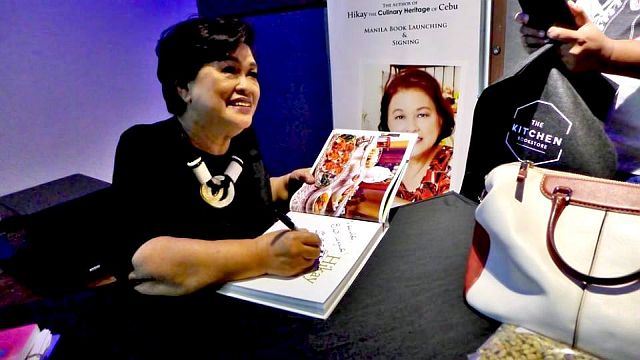
Louella Alix signs copies of her book Hikay.
QUEZON CITY — Louella Theresa Eslao-Alix started writing professionally when she was 59 years old.
Before that, she was running Presents and Such, a gift shop located along Gorordo Avenue in Barangay Lahug, Cebu City.
She was — and still is — a full-time and dedicated housewife to Rudy, mother to daughters Patricia and Maia, and grandmother to four grandsons Vito, Wanco, Manolo and Raoul.
At 64, the University of San Carlos (USC) Press published her book “Hikay: The Culinary Heritage of Cebu,” her obra maestra that marries her love for food and history.
“To describe Cebuano cooking is to describe the Cebuanos: simple, uncomplicated, fresh, straightforward, and thrifty. When a Cebuano invites you to eat at his home, you should be flattered because it means he is sharing food closest to his heart,” Eslao-Alix said in her book talk last August during the launching of “Hikay” in Quezon City.
The story of Cebu’s rich culinary heritage took center stage in the national arena as her book was launched at the Quezon Experience with Quezon City Vice Mayor Maria Josefina Belmonte-Alimurung welcoming guests and participants.
“The book contains comprehensive historical and cultural snippets of Cebu’s rich culinary heritage. I have had wonderful opportunities to visit the many cities and municipalities of Cebu as an archaeologist and tasted Cebuano dishes,” said Belmonte-Alimurung, who spent three months in Cebu to dig up Plaza Independencia in 2000 when she was working with the National Museum.
Belmonte-Alimurung praised Cebu lechon and said that part of their tourism plan is to bring the lechoneros of Quezon, who used to be known to produce good lechon, to learn from the experience of Cebu.
The launching was made possible by The Kitchen Bookstore, an online bookshop owned by Rajiv Daswani, who read an article about Hikay in 2014.
He got in touch with USC Press which led him to Eslao-Alix.
“Not many books are written about Filipino food and I saw Hikay and the quality is perfect because nothing (this comprehensive) has been writing about Cebuano cuisine,” said Daswani.
In April 2015, he opened The Kitchen Bookstore (www.thekitchenbookstore.com) and Hikay has been one of the best-selling titles based on online orders and book fair sales.
Tetta Tirona, who sits as chairperson of the Quezon City Tourism Council, said it was easy to bring together partners to organize the book launching because discovering the work of Eslao-Alix is finding good writers which present what is genuinely good about Filipinos.
In her presentation, Eslao-Alix gave participants a visual feast of Cebu’s geographical terrain which shaped the type of ingredients and determined the method of cooking employed by the Cebuanos.
Eslao-Alix is not a professional chef but she was trained in the kitchen of her Lola Nila (Leonila Abao), a Home Economics teacher.
In writing the book, she went around the different towns and cities of Cebu province, cooking and testing more than 200 recipes before choosing 50 Cebuano culinary gems to be included in the book.
She worked with Catholic priest, Father Jun Rabayla, and her husband Rudy for the book’s photography.
These days, she is gathering materials for Book 2 of “Hikay” and preparing her armory of stories (and recipes) for the Power of Pen: Food Writing Workshop to be held in Cebu on Nov. 19 where she will serve as one of the speakers.
